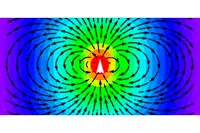 Researchers at the University of Cambridge say they have unravelled one of the mysteries of electromagnetism and add their work could allow the creation of antennas small enough to be integrated into a chip.
Researchers at the University of Cambridge say they have unravelled one of the mysteries of electromagnetism and add their work could allow the creation of antennas small enough to be integrated into a chip.
"Antennas are one of the limiting factors when trying to make smaller and smaller systems, since below a certain size, the losses become too great," said Professor Gehan Amaratunga of Cambridge's Department of Engineering, who led the research.
The team has proposed that electromagnetic waves are not only generated from the acceleration of electrons, but also from a phenomenon known as symmetry breaking. In addition to the implications for wireless communications, the discovery could help identify the points where theories of classical electromagnetism and quantum mechanics overlap.
According to the researchers, certain physical variables associated with radiation of energy are not well understood. While Maxwell determined that electromagnetic radiation is generated by accelerating electrons, this theory is said to become problematic when dealing with radio wave emission from a dielectric solid – already used for antennas in mobile phones, for example.
"In dielectric aerials, the medium has high permittivity, meaning the velocity of the radio wave decreases as it enters the medium," said researcher Dr Dhiraj Sinha. "What hasn't been known is how the dielectric medium results in emission of electromagnetic waves. This mystery has puzzled scientists and engineers for more than 60 years."
Working with the National Physical Laboratory and Cambridge based Antenova, the team used thin films of piezoelectric materials and found that, at a certain frequency, these materials become not only efficient resonators, but also efficient radiators. The researchers believe this is due to symmetry breaking of the electric field associated with the electron acceleration.
"If you want to use these materials to transmit energy, you have to break the symmetry, as well as have accelerating electrons – this is the missing piece of the puzzle of electromagnetic theory," said Prof Amaratunga. "I'm not suggesting we've come up with some grand unified theory, but these results will aid understanding of how electromagnetism and quantum mechanics cross over and join up. It opens up a whole set of possibilities to explore."
Author
Graham Pitcher
Source: www.newelectronics.co.uk

